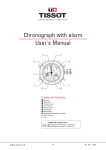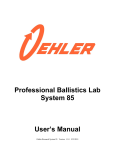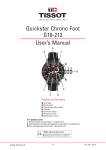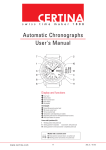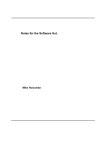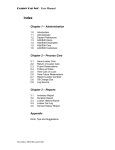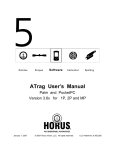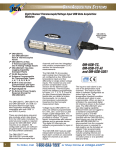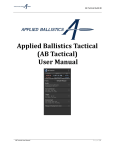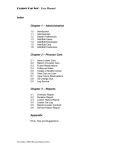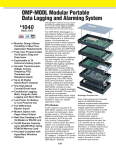Download to System 85 Brochure in format.
Transcript
Oehler System 85 Ballistic Instrumentation for the Next Generation The System 85 replaces the venerable Oehler Model 82. The System 85 measures two pressures, action time, muzzle velocity, and targeting with time of flight and ballistic coefficient. It can operate as a machine‐gun chronograph. Each System 85 includes its own built‐in firing simulator for training, system set‐up, and eventual trouble‐shooting. It automatically exports all test data to Excel files. The following data are available for display and printed report during normal slow fire testing: Pressure A (Mid‐Case or Casemouth) Graph vs Time, Peak Pressure Time to Peak, Rise Time Area Under Curve Optional Low Pass filters Pressure B (Mid‐Case, Casemouth, or Barrel) Graph vs Time, Peak Pressure Time to Peak or Action Time Rise Time, Area Under Curve Optional Low Pass filters Instrumental Velocity Velocity Proof Velocity Difference Downrange Target Target Coordinates Horizontal and Vertical Time of Flight Ballistic Coefficient Velocity at Target The following data are displayed and reported for each round during machine‐ gun mode: Instrumental Velocity Epoch Time Rate‐of‐Fire Conformal and Casemouth Pressure Test Displayed Graphic and Numerical Data Software Drivers During set‐up the operator is prompted to enter appropriate data for test conditions, gun and transducer information, load information and other items of interest. This information is included on the printed report and is also transferred to the Excel data file at the completion of a test. The interface between the System 85 and the controlling PC is cleanly defined. Users can provide appropriate software drivers if the System 85 hardware is used for specialized tests employing Labview or other languages. Appropriate statistics are continually available for each measured data channel. You can select the two pressure curves and up to ten parameters for display and report. All available channels are stored in Excel along with raw times and raw data for the pressure curves. Input Requirements The System 85 communicates with the Windows PC via the powered USB port. Power for the System 85 comes from the USB bus. The following input signals are recognized at standard levels through standard connectors. Fire +12 volt pulse; an alternate connector allows direct connection to action‐time switch. Pressure A 0→10 volt analog signal. Typically used for chamber pressure. Pressure B 0→10 volt analog signal. Typically for down‐barrel port pressure. Start +12 volt pulse from muzzle velocity start screen. Mid +12 volt pulse from middle screen. (Optional redundant measure of velocity.) Stop +12 volt pulse from muzzle velocity stop screen. Target Four nominal +12 volt pulses from the four microphones of an acoustic target located downrange. Pressure Conversion and Capture The System 85 uses two 12‐bit A/D units to simul‐ taneously sample two pressure signals at either 5 or 10 μs intervals. Sampling begins in anticipation of a shot and continues for 320 samples after Pressure A reaches 1 volt. The system returns the last 400 samples of each pressure. Optional Bessel and Butterworth low‐pass filters may be applied before analysis and display, but raw data is always stored without filter application. Firing Simulator The requirement for a firing simulator has been demonstrated repeatedly. An extensive simulator is built into each System 85. Outputs include a fire signal, peak pressures in steps from 1 to 8 volts, muzzle screen signals, and simulated signals from the acoustic target microphones for a target group. While the simulator is conveniently housed in the box with the System 85, it is electrically independent. It even has its own battery power supply. Additional Information Available Try as we might, we cannot describe the System 85 in a short brochure. We hope only to convince you to learn more about the System 85. The System 85 will sell itself. A good introduction is having the System 85 software installed on your desktop computer with the User’s Manual in your lap. We will be happy to send you a copy of the User’s Manual plus a CD with the set‐up file and some sample data. You can replay our tests, print reports, transfer data to Excel and do everything except fire your own tests. For a thorough evaluation of the System 85, it is best to use it. Loan systems are available; each includes its firing simulator. You can simulate a complete instrumentation system on a tabletop. You can set up tests, fire simulated rounds, observe the display, print reports, export data to Excel and even simulate sensor faults. Better yet, you can take the System 85 into your lab and connect your sensors to see how it works in the real world. We’d be pleased to arrange for your demo system. Oehler Research, Inc. PO Box 9135 Austin, Texas 78766 Phone 512 327 6900 sales@oehler‐research.com Why Oehler System 85? Economical Available Customers buy Oehler systems to save money. The users appreciate the accuracy, convenience and reliability of our equipment, but purchase decisions are made by those with the checkbook. They buy based on long‐range economy. Prices for ballistic test equipment are primarily determined by development costs. That’s the nature of a small market requiring specialized equipment. Historically, Oehler has funded all development costs for their products. These costs are recovered as equipment is sold; each piece sold carries the burden of a fraction of the costs. Our policy of dividing the development costs results in lower costs for each user. Training costs are associated with any new system. Operators can use the System 85 with minimal training. Oehler’s experience in ballistic testing lets us think like the operators think, and that lowers training costs. The built‐in firing simulator allows training without the burden of actual firing range time. Often unrecognized, continual support is required during the lifetime of any system. The Model 82 is still in common use, but it was designed even before computers used DOS. Oehler adapted the original design and hardware so that it functions with later computers. Equipment built in‐house must receive similar support from in‐house engineers, hardware suppliers and software vendors. Oehler provides such support economically. Very few companies support products over long lifetimes of ten or twenty years. Oehler tries. To assure such support, we urge you to consider an extended warranty for the System 85. This will include all software and firmware updates, semi‐ annual calibrations, and the expectation of over‐ night delivery of loaners in the event of hardware malfunction. A fee of ten percent of the prevailing purchase price will be charged each year. Damage caused by bullets or lightening will be repaired at extra charge. Oehler can provide this service cheaper than you can do it in‐house. Oehler offers both replacement loans and demo systems. Oehler’s hardware and software are real. Oehler offers more than just user want‐lists and vendor’s promises. We’ve paid the development costs and we have the proven hardware on the shelf. This brute‐force approach assures that you have a reliable source for future hardware requirements. As loan units are returned, they are repaired and recalibrated as required and are ready for dispatch. Universal Language The reports printed by the System 82 established a universal language for test results. Reports from the System 85 are even more complete, but they are still simple. It’s easy to share data between individuals, between departments or even between facilities and organizations. The report for a twenty‐shot test is complete on one page; it fits a copy machine. Reports are in .pdf format for convenient e‐mail. Complete Archives The System 85 can automatically export all test data as an Excel file to a designated folder. We chose the Excel format because it is stable and most users are familiar with it. You can extract all required information with minimal cost. The System 85 also saves the test data in its own TestData.s85 files. These files of raw data and test conditions can be replayed to see results on the screen, to print extra copies of the report or to accept edited test conditions. Single Source Responsibility Oehler offers single source responsibility. We’ve provided pressure read‐outs, chronographs, velocity screens, and acoustic targets for many years. You’ve taught us much about ballistic testing, from the big picture down to nitty‐gritty gremlins that bedevil even the most experienced users. If our systems don’t work like you expect, you call Oehler. Rear Panel Showing System 85 Inputs and Firing Simulator




